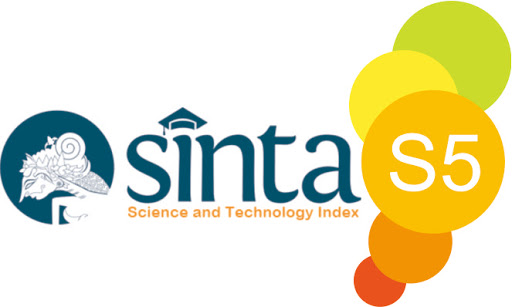POTENSI TANAMAN BROTOWALI (Tinospora cordifolia) SEBAGAI IMUNOSTIMULAN PADA IKAN
DOI:
https://doi.org/10.36526/jl.v5i3.2967Keywords:
Brotowali, Imunostimulan, Budidaya IkanAbstract
Usaha pengembangan budidaya ikan tidak dapat terlepas dari adanya penyakit. Manajemen kesehatan ikan yang dapat diterapkan dalam mengendalikan serangan penyakit salah satunya dengan melakukan tindakan pencegahan penyakit ikan melalui pemberian imunostimulan. Sumber imunostimulan alami dapat berasal dari tanaman. Kandungan dalam tanaman alami dapat menjadi imunostimulan bagi ikan, salah satunya adalah brotowali (Tinospora cordifolia). Brotowali umumnya diketahui sebagai bahan baku pembuatan jamu pahitan yang memiliki banyak manfaat untuk tubuh manusia karena kandungannya. Oleh karena itu tujuan dari studi literatur (literature review) ini adalah agar dapat memberikan gambaran yang jelas mengenai potensi dari brotowali tersebut sebagai imunostimulan pada ikan. Metode yang digunakan yaitu systematic literature review dengan tahapan planning, data collection, data analysis, kemudian diakhiri dengan simpulan. Hasilnya diketahui bahwa brotowali memiliki berbagai kandungan senyawa yang dapat digunakan sebagai imunostimulan pada budidaya ikan. Tanaman brotowali sangat berpotensi untuk dilakukan pengembangan penelitian lebih lanjut dalam upaya untuk menjadikan bahan tersebut sebagai imunostimulan pada budidaya ikan.
References
Alexander, C. P., Kirubakaran, C. J. W., & Michael, R. D. (2010). Water soluble fraction of Tinospora cordifolia leaves enhanced the non-specific immune mechanisms and disease resistance in Oreochromis mossambicus. Fish & Shellfish Immunology, 29(5), 765–772. https://doi.org/10.1016/j.fsi.2010.07.003
Anita, Dubey, M. K., Khati, A., & Chauhan, R. S. (2016). Immunostimulatory and growth promoting potential of Tinospora cordifolia (Thunb.) miers on fingerlings of amur carp. Indian Journal of Experimental Biology, 54(10), 659–663.
Ariefqi, M. N., Syamsunarno, M. R. A. A., & Rosdianto, A. M. (2020). UTILIZATION OF EFFICACIOUS HERBS AS SUPPLEMENTS IN DISEASE CONTROL IN AQUACULTURE: A LITERATURE REVIEW. Indonesia Medicus Veterinus, 9(6), 1000–1009. https://doi.org/10.19087/imv.2020.9.6.1000
Awad, E., & Awaad, A. (2017). Role of medicinal plants on growth performance and immune status in fish. Fish & Shellfish Immunology, 67, 40–54. https://doi.org/10.1016/j.fsi.2017.05.034
Disi, M. Z. A. (2022). ETNOBOTANI TUMBUHAN BERACUN DAN PEMANFAATANNYA DI MALUKU UTARA, INDONESIA. Kieraha Medical Journal, 4(2), 82–88. https://doi.org/10.33387/kmj.v4i2.5522
Elumalai, P., Kurian, A., Lakshmi, S., Faggio, C., Esteban, M. A., & Ringø, E. (2020). Herbal Immunomodulators in Aquaculture. Reviews in Fisheries Science & Aquaculture, 29(1), 33–57. https://doi.org/10.1080/23308249.2020.1779651
Jasmanindar, Y., Salosso, Y., & Dahoklory, N. (2020). Imunostimulan (Gracilaria verrucosa) pada Budidaya Ikan Lele (Clarias sp). Jurnal AQUATIK, 3(2), 67–72. https://ejurnal.undana.ac.id/index.php/jaqu/article/view/3235
Kurniawan, A. (2013). SHORT COMMUNICATION: POTENSI TANAMAN HERBAL UNTUK IMUNITAS IKAN TERHADAP PAPARAN BAKTERI Aeromonas sp. AKUATIK-Jurnal Sumberdaya Perairan, 7(1), 9–14.
Latha, C., Krishnakumar, V., & Munuswamy, N. (2020). Growth, Survival and Haemato-Biochemical Profiles of the Freshwater Catfish, Pangasius sutchi (Fowler, 1937) Fingerlings Fed With Tinospora cordifolia Leaf Extract Supplemented Diet. Egyptian Journal of Aquatic Biology and Fisheries, 24(1), 249–262. https://doi.org/10.21608/ejabf.2020.70687
Malik, M. M. (2015). THE POTENTIAL OF BROTOWALI STEM EXTRACT (Tinospora Crispa) AS ANALTERNATIVE ANTIMALARIAL DRUG. J Majority, 4(5), 45–49.
Miriam, R., Nathalie, T.-B., Pierre, S., & Denis, S. (2017). Use of Medicinal Plants in Aquaculture. In Diagnosis and Control of Diseases of Fish and Shellfish (pp. 223–261). John Wiley & Sons, Ltd. https://doi.org/10.1002/9781119152125.ch9
Murshid, G. M., Kundu, S. K., Sohrab, M. H., & Mazid, M. A. (2022). Pharmacological Overview of Tinospora cordifolia, an Ethnologically Important Plant of Bangladesh. Pharmacology & Pharmacy, 13(03), 93–106. https://doi.org/10.4236/pp.2022.133007
Nafiqoh, N., Andriyanto, S., Novita, H., Sugiani, D., & Taukhid, T. (2021). KOMBINASI SIRIH DAN KIPAHIT SEBAGAI IMUNOSTIMULAN TERHADAP PENYAKIT Streptococcosis PADA IKAN NILA (Oreochromis niloticus). Jurnal Riset Akuakultur, 16(1), 39–47. https://doi.org/10.15578/jra.16.1.2021.39-47
Razak, A. P., Kreckhoff, R. L., & Watung, J. C. (2017). Administrasi oral imunostimulan ragi roti (Saccharomyces cerevisiae) untuk meningkatkan pertumbuhan ikan mas (Cyprinus Carpio L.). E-Journal BUDIDAYA PERAIRAN, 5(2), 27–36. https://doi.org/10.35800/bdp.5.2.2017.16637
Salkar, K., Chotalia, C., & Salvi, R. (2015). Tinospora cordifolia : An Antimicrobial and Immunity Enhancer Plant. International Journal of Science and Research, 6(3), 1603–1607.
Sanmugarajah, V., Rajkumar, G., & Panambara, P. A. H. R. (2022). A Detail Review on Heart-Leaved Moonseed (Tinospora cordifolia) Medicinal Plant. Journal of Tropical Pharmacy and Chemistry, 6(2), 154–166. https://doi.org/10.25026/jtpc.v6i2.466
Sharma, A., Chadha, N. K., Das, S. K., Sen, A., Roy, S. D., Chanu, T. I., Sawant, P. B., & Prakash, C. (2017). Tinospora Cordifolia Extract Induced Effects on Cellular Immune Reactions of Labeo rohita (Hamilton) Challenged Against Aeromonas hydrophila. International Journal of Pure & Applied Bioscience, 5(5), 765–775. https://doi.org/10.18782/2320-7051.5120
Singh, B., Sharma, P., Kumar, A., Chadha, P., Kaur, R., & Kaur, A. (2016). Antioxidant and in vivo genoprotective effects of phenolic compounds identified from an endophytic Cladosporium velox and their relationship with its host plant Tinospora cordifolia. Journal of Ethnopharmacology, 194(september), 450–456. https://doi.org/10.1016/j.jep.2016.10.018
Stratev, D., Zhelyazkov, G., Noundou, X. S., & Krause, R. W. M. (2018). Beneficial effects of medicinal plants in fish diseases. Aquaculture International, 26(1), 289–308. https://doi.org/10.1007/s10499-017-0219-x
Sudhakaran, D. S., Srirekha, P., Devasree, L. D., Premsingh, S., & Michael, R. D. (2006). Immunostimulatory effect of Tinospora cordifolia Miers leaf extract in Oreochromis mossambicus. Indian Journal of Experimental Biology, 44(9), 726–732.
Sutiani, L., Bachtiar, Y., & Saleh, A. (2020). Analisis Model Budidaya Ikan Air Tawar Berdominansi Ikan Gurame ( Osphronemus Gouramy ) di Desa Sukawening, Bogor, Jawa Barat. Jurnal Pusat Inovasi Masyarakat, 2(2), 207–214.
Syahidah, A., Saad, C. R., Daud, H. M., & Abdelhadi, Y. M. (2015). Status and potential of herbal applications in aquaculture: A review. Iranian Journal of Fisheries Sciences, 14(1), 27–44.
Upreti, P., & Chauhan, R. S. (2018). Effect of leaf powder of giloy (Tinospora cordifolia) in fish feed on survival and growth of post larvae of Catla catla. Journal of Applied and Natural Science, 10(1), 144–148. https://doi.org/10.31018/jans.v10i1.1594
Utami, W., Sarjito, & Desrina. (2016). Pengaruh salinitas terhadap efek infeksi Vibrio harveyi pada udang vaname (Litopenaeus vannamei). Journal of Aquaculture Management and Technology, 5(1), 82–90. https://ejournal3.undip.ac.id/index.php/jamt/article/view/10691
Vaseeharan, B., & Thaya, R. (2013). Medicinal plant derivatives as immunostimulants: an alternative to chemotherapeutics and antibiotics in aquaculture. Aquaculture International, 22(3), 1079–1091. https://doi.org/10.1007/s10499-013-9729-3
Wiratno, Nurhayati, H., & Sujianto. (2019). PEMANFAATAN BROTOWALI (Tinospora crispa (L.) Hook.f & Thomson) SEBAGAI PESTISIDA NABATI. Perspektif, 18(1), 28–39. https://doi.org/10.21082/psp.v18n1.2019
Downloads
Published
How to Cite
Issue
Section
License
Copyright (c) 2024
This work is licensed under a Creative Commons Attribution-ShareAlike 4.0 International License.











